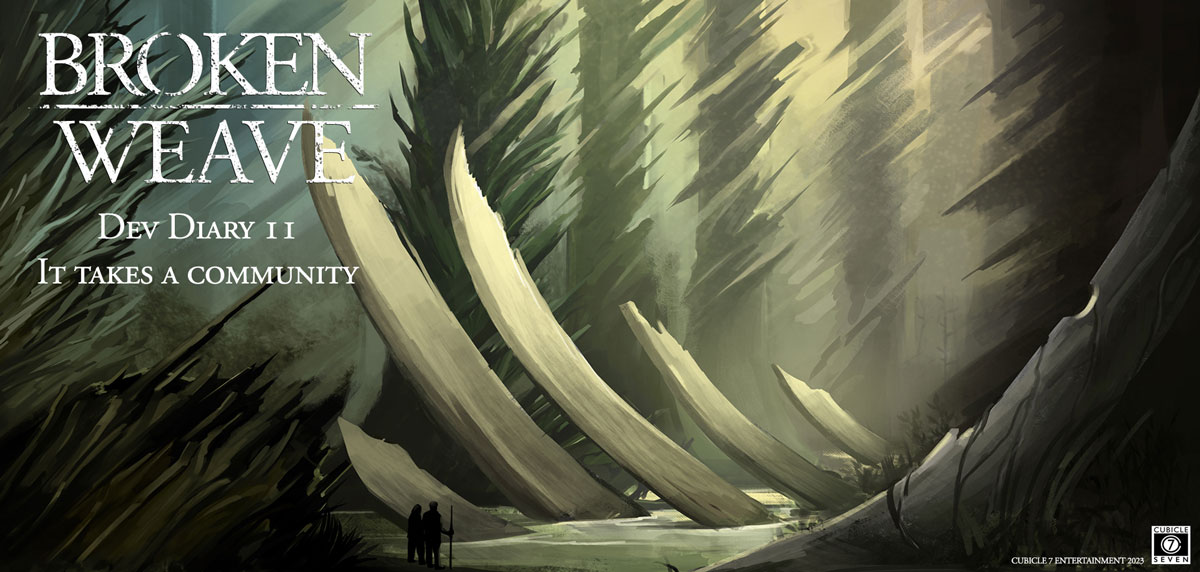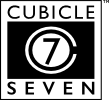Broken Weave Dev Diary 11: It Takes a Community

Greetings Survivors.
It takes a lot of people a long time to create a world from scratch, especially one as surreal and strange as the Broken World. In our previous developer blogs we’ve talked about how the artists developed the evocative visual style of Broken Weave, from environments, to monsters, and the various classes you can expect to play. Now it’s the writers and designers’ turn!
The Broken Weave is in its final few days on Kickstarter. It’s fully funded and with a wealth of Stretch Goals unlocked, so be sure to check it out.
Question 1
‘Magic is broken and the gods are dead’ was the original seed for Broken Weave. What were your first thoughts about the setting when you started working on it?
Cat Evans (he/they): When I approach really dark settings, my first question is always “why do people bother getting up every day?”, so my first act is always to find the answer to that question. They say “hope springs eternal”; however terrible the present is, there’s a chance tomorrow could be better. So in Broken Weave the core of the game is hope: not just living in this awful situation but finding ways to thrive in it and maybe even leave the world better than you found it.
Alex Clippinger (he/him): I was given the same frames of reference for the elevator pitch: Dark Souls, Shadow of the Colossus, etc. I was pretty excited to do something tragic and thoughtful—I’m a big fan of those inspirations and ended up bringing a love of Darkest Dungeon into some specific designs, too! At the same time, tabletop games are about cooperation between your fellow players and with the GM; you can’t quite capture that same total solitude of a Souls game and we would have been goofy to try. I really like that we immediately pushed away from utter misery or Mad-Max-style over-the-top pulp style and tried to do something a little bit different, commit to our vision of the setting.
Jessica Marcrum (she/her): One of the first reference points I was given was a group of characters sitting around a campfire, because light is the only thing keeping us safe. Danger lurks in darkness and may be the darkness itself. I loved the idea that people have to come together, to forge bonds and relationships, not to fight the dark but to merely survive. When titans roam the earth heedless to your tiny existence, there is little point in fighting them. With a functional group, however, you can potentially relocate your home out of their way. The chance to showcase alternative methods to threat management besides “kill, level up, kill bigger,” was very appealing.
Question 2
There was a lot of collaboration between the art and writing team on Broken Weave, with art inspiring writing and writing inspiring art. What’s your favourite piece that inspired you, or that was illustrated from something you created?
Cat Evans (he/they): I refuse to pick just one, and you can’t make me! Hah! I love how Sam Manley took monster names and made the most horrific, nightmare entities - which fully embodied the themes of decay and coming apart. I love Runesael Flynn’s determination to bring the light and hope: he made the beautiful Speakthief (it’s nasty. Don’t pet it.) and created entire, elegant chunks of worldbuilding with ideas like Waypoints: when paths are unreliable, people find ways to light the way.
OK fine, my favourite-favourite is Momma Possum. I said community’s a big deal in Broken Weave and I love how Momma, with her young clinging to her, illustrates a monstrous version of that: a weight she can’t, and wouldn’t dream of, putting down but that’s also so much part of her you can’t imagine her without them.
Cody Faulk (he/him): The piece I most vividly recall is Runesael Flynn’s sketch of the sun’s rays literally slicing through a copse of trees. Even in black and white, that one resonated with me a great deal for some reason, so much so that it practically screamed the need for it to be something meaningful enough that characters could interact with it more than just in passing. That meant it needed some sort of mechanics around it. The idea ultimately became Razorshine, a phenomenon of Decay that warps the sun’s rays into scathing beams that cut apart whatever they touch. Even though the sun is an incredibly important source of Hope in the Broken World, savvy survivors learn that even the welcome sight of the rising sun can destroy them if they can’t stave off the horrors of Decay.
Jessica Marcrum (she/her): It’s so hard to pick just one. I absolutely adore the rat dragon, though [by Sam Manley]. As soon as I saw that little creature, I absolutely had to stat it up. I love adorable monstrous beings, and the rat dragon is wonderfully pesky. I’m very much looking forward to seeing some of the locations I created come to life.
Question 3
Between bold new character Classes, nightmarish Decayed Monsters, new mechanics, and more, Broken Weave is bursting with creative ideas. What’s the one thing you’re most proud of contributing to the book, and why are you excited for players and GMs to experience it?
Alex Clippinger (he/him): Definitely resting rules and downtime! I think making a system without on-demand healing magic made us emphasise the importance of rest and recovery from a character perspective, and then gave us a lot of room to consider Havens as places where you’re going to spend a lot of time. I had an opportunity to do a lot of cool system stuff to 5E, but I think downtime and rest is where players will make a lot of broad choices about who their characters are; what their priorities are, what they value, and what kind of community they want to encourage in the Broken World.
Cody Faulk (he/him): It’s hard to pick one thing, so I’ll pick two. While Decay wasn’t my idea, I did most of the writing about what it is and how it functions. We knew it was scary, but we didn’t really know how until we got into it. I could talk for hours about what it represents philosophically in the setting, but in short: it’s nothing good. It’s reality rotting in place because it doesn’t realise it’s already dead.
And as horrific as that is, we couldn’t leave Decay unopposed, so that led to creating Hope to give survivors a means and a reason to keep trying. I think we did an awesome job informing the setting, tone, and themes of Broken Weave through the mechanical and narrative interplay between Hope and Decay.
But deep down, I really just want everyone to see the Harrowed in all their “stare not into the abyss” glory and think they’re as cool as I do.
V.J. Harris (they/he): God it’s so hard to choose one thing! I got to make some lineages which is my bread and butter but also worked on some really cool subclasses but I think I’ll have to settle on Life Path. Working to come up with so many choices so that players could feel like the sky was the limit was really a test of my creative capabilities, especially since I’d never worked on anything like it before. I think the possibilities laid out are going to be a boon to new and old players.
KC Shi (she/her): I enjoyed the challenge of fleshing out the setting of the Broken World, Where Everything is Broken. The moon? Broke it. The economy? Broke it. The fundamental nature of space, time, and causality? Screw it, let’s smash that to bits too. It was the worldbuilding equivalent of being a bull in a china shop, and I think that feeling is core to the appeal of any post-apocalyptic setting. But the “post” half of “post-apocalyptic” is really where the setting’s focus lies, and I found it just as satisfying to pick through the pieces and build a new mosaic out of all these shattered tropes and story elements. When players start making their own versions of the Broken World, I hope they indulge in those twin creative joys. For better or worse, anything can be broken, and anything can be made out of what remains.
Outro
The Broken Weave Kickstarter is in its final few days on Kickstarter. It’s fully funded and with a wealth of Stretch Goals unlocked, so be sure to check it out.
- The Cubicle 7 Team




 Twitter
Twitter Facebook
Facebook Youtube
Youtube